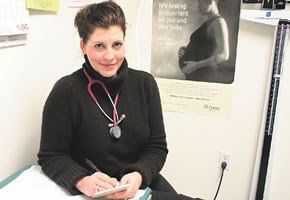BY HEIDI ULRICHSEN
Jennifer Fournier-Gervais used to spend her days caring for people with broken arms, gaping cuts and pneumonia as an emergency room nurse at St. Joseph’s Health Centre.
She decided she’d like to increase her education beyond her college nursing diploma, and earned a bachelor’s degree in nursing at Laurentian University. She then entered the school’s post-bachelor’s nurse practitioner program.
“The training was fairly intensive. It took up pretty much all of my time. You certainly had to be self-motivated because the type of training they do is problem-based. You are responsible for what you need to do and how you learn it.”
Fournier-Gervais, 36, now works as a nurse practitioner at the Shkagamik-Kwe Health Centre, which provides culturally appropriate care for about 3,000 aboriginal patients in the city.
Another nurse practitioner, two family doctors, two social workers, a medicine man and various other health professionals also work at the downtown centre. Traditional native medicine is provided on top of western medications and treatments.
But not everybody is as lucky as the patients cared for at Shkagamik-Kwe, says Fournier-Gervais. There’s a primary health crisis in Greater Sudbury.
About a quarter of the city’s population have no stable access to one-on-one care for their health conditions. They rely on walk-in clinics and the hospital emergency room instead.
In recent years, more and more nurse practitioners have been stepping in to care for these patients, she says.
There are now 12 nurse practitioners working in Greater Sudbury in the primary health field, and seven more in other areas of care.
The expansion of the field has been slow because the province provides funding for specific nurse practitioner positions. The province has funded about 400 new nurse practitioner positions since 1998, but more are needed, says Fournier-Gervais.
Nurse practitioners working in Ontario must have a bachelor’s degree in nursing, two years of experience in their field within the past five years, and a post-bachelor’s nurse practitioner certificate.
Laurentian’s nurse practitioner program consists of five courses and clinical placements, and takes one to three years to complete, depending on how much time the student can devote to their studies.
With the collaboration of doctors, nurse practitioners can prescribe certain medications, diagnose, treat and monitor minor illnesses, order specific X-rays, lab tests and ultrasounds, and provide preventative care.
“I love what I do. I love the variety of the patients I see. I love that you can see the effects of the work you do over time,” Fournier-Gervais says.
“In primary care you have the opportunity to care for patients over a long period of time. When you care for someone in the hospital, your relationship with him or her is very short.
“For example, I can follow a pregnant mom and the baby from before conception, watch them through the time to when she delivers and watch the baby grow into a teenager. It’s very exciting.”
Fournier-Gervais doesn’t like being compared to a doctor. Nurse practitioners are not physician assistants or “mini doctors,” she says, but expert nurses functioning at an advanced practice level.
“We work from a nursing perspective. Even if at the end of the visit we prescribe the same drug, the path we follow might be a little different. We focus a lot on teaching and client support. Visits tend to be longer.”
After months of lobbying by nurse practitioners and local politicians, the province promised more than $1 million last fall for the creation of a family health team clinic in Greater Sudbury run by nurse practitioners.
Organizers hope it will be up and running in April. The clinic will serve up to 5,000 people.
Six nurse practitioners, collaborative family doctors, a social worker and a dietitian will work at the clinic.
Its main location will be in the downtown core of Greater Sudbury and there will be satellite locations in Dowling and Chapleau.
Roberta Heale, who teaches in the nurse practitioner program at Laurentian University, spearheaded the application along with her colleague, Marilyn Butcher.
They pushed for the clinic because there was a “glut” of seven nurse practitioners who could not get work in their field in the city because not enough positions were funded by the government.
Two of these nurse practitioners have since moved to other communities because they couldn’t wait long enough for the new clinic to open.
But more funded positions are needed because there’s another class of 18 about to graduate from Laurentian’s nurse practitioner program, and some of them will want to stay in Greater Sudbury, says Heale.
These newly minted nurse practitioners can help people in the city access primary health care.
“I really feel that nurse practitioner care is one option that we know can work very well. It’s not going to solve every problem. But I think it’s just one piece out of the puzzle,” she says.
“There’s a huge number of people in this area without primary health services. My concern is that we won’t even make a dent. We will take up to our capacity, but we don’t know how much of that will help.”
Sudbury and District Medical Society president Dr. Dennis Reich says he’s a big supporter of working with nurse practitioners.
But he’s not sure setting up a stand-alone nurse practitioner clinic is the best use of the city’s health-care resources, although he agrees more funded positions are needed.
Nurse practitioners should be working alongside doctors at existing walk-in clinics and other medical facilities, he says.
“Taking 2,000 or 3,000 patients out of 40,000 that have no family doctor and giving them Cadillac care is not the best use of nurse practitioners,” Reich says.
“It would be a drop in the bucket of what’s needed. We don’t have a shortage of medical facilities. We have a shortage of manpower.”
